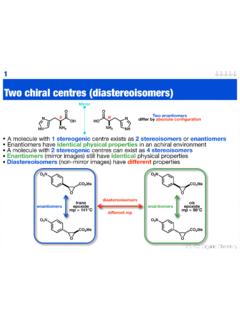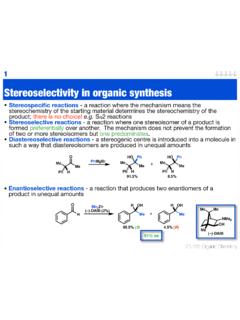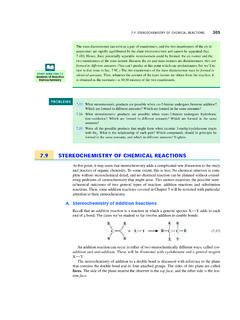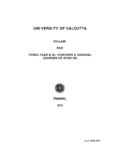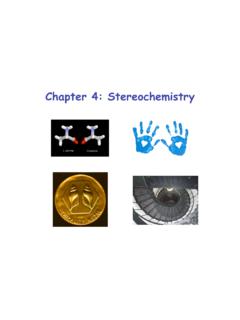Transcription of Enantiomeric excess - Massey University
1 Advanced organicEnantiomeric excess Optical purity - an outdated measurement of the Enantiomeric excess (amount of two enantiomers) in a solution / mixture If a solution contains only one enantiomer, the maximum rotation is rotationderive [ ]D = +14100% (+) enantiomer100% of maximum observed rotationCO2HH2 NHmeasure rotationderive [ ]D = -14100% ( ) enantiomer100% of maximum observed rotation The observed rotation is proportional to the amount of each enantiomer organicEnantiomeric excess II290% (+) enantiomer10% ( ) enantiomer=+90% clockwise10% anti-clockwise80% of maximum rotation observed60% (+) enantiomer40% ( ) enantiomer60% clockwise40% anti-clockwise=+=+50% (+) enantiomer50% ( )
2 Enantiomer50% clockwise50% anti-clockwise10% of major enantiomer is cancelled out 40% of major enantiomer is cancelled out 20% of maximum rotation observed50% of major enantiomer is cancelled out 0% of maximum rotation observedAdvanced organicEnantiomeric excess III Previous slide indicates that a polarimeter measures difference in the amount of each enantiomer Racemate (racemic mixture) - 1 to 1 mixture of enantiomers (50% of each) Racemisation - converting 1 enantiomer to a 1:1 mixture of enantiomers Optical rotation very unreliable so use new methods to measure amounts and use the value Enantiomeric excess How do we measure Enantiomeric excess ?
3 Problem - all the physical properties of enantiomers are identical (in an achiral environment) except rotation of plane polarised light Solution - the interaction of a chiral molecule with other chiral compounds is different depending on the enantiomer Imagine you have a mixture of left and right-handed gloves and you are asked to separate there is a power cut, and you are left in a darkened room. How would you do it? Use just one hand and try the gloves excess (% ee) = [R] [S][R] + [S]= %R %SAdvanced organicResolution of enantiomers.
4 Chiral chromatography Resolution - the separation of enantiomers from either a racemic mixture or enantiomerically enriched mixture Chiral chromatography - Normally HPLC or GC A racemic solution is passed over a chiral stationary phase Compound has rapid and reversible diastereotopic interaction with stationary phase Hopefully, each complex has a different stability allowing separation4racemic mixture in solution matched enantiomer - more stable (3 interactions) mis-matched enantiomer - less stable (1 interaction) matched enantiomer travels slowly mis-matched enantiomer readily elutedchiral stationary phaseAdvanced organicChiral chromatography Measurements of ee by HPLC or GC are quick and accurate ( ) Chiral stationary phase may only work for limited types of compounds Columns are expensive (> 1000)
5 Need both enantiomers to set-up an accurate method5 SiNHONO2NO2 SiOSiSiOOOOOSiOSiOOOOOMeMesilicachiral aminechiral stationary phaseRSR/SRSSR inject mixture on to columnchiral column prepared from a suitable chiral stationary phase (many different types)RAdvanced organicNMR spectroscopy: chiral shift reagents Chiral paramagnetic lanthanide complexes can bind reversibly to certain chiral molecules via the metal centre Process faster than nmr timescale and normally observe a downfield shift (higher ppm) Two diastereomeric complexes are formed on coordination.
6 These may have different nmr signals Problems - as complexes are paramagnetic, line broadening is observed (especially on high field machines) Compound must contain Lewis basic lone pair (OH, NH2, C=O, CO2H etc) Accuracy is only 2%6 OEuL2OC3F7+substrateEu(hfc)3Eu(hfc)3 substrateAdvanced organicChiral shift reagents II New reagents are being developed all that time that can overcome many of these problems 1H NMR spectra (400 MHz) of valine ( M, [D]/[L] = 1 ) in D2O at pH OONNOOMeHOOOOSm3+Advanced organicMeOMeOOMeOMeOO+2 diastereoisomersCO2 HMeOMeDCC, DMAP, DCM, rt, 24h+enantiomerically pureOHOH+=mixture of enantiomersOH( )
7 RacemateChiral derivatising agents A racemic mixture of enantiomers can be converted to a mixture of diastereoisomers by covalently attaching a second, enantiomerically pure unit The advantage of this over the previous methods is there is normally larger signal separation in nmr There is no reversibility Diastereoisomers can often be separated by normal, achiral chromatography8 To understand why diastereoisomers are useful we need to do some more organicTwo chiral centres A molecule with one stereogenic centre exists as two stereoisomers or enantiomers The two enantiomers differ by their absolute configuration A molecule with two stereogenic centres can exist as four stereoisomers9NH2 HNNOOHNH2 NHNOHOSRM irrorenantiomersdifferent absolute configurationOHNH2(1R,2S)OHNH2(1S,2S)OHN H2(1R,2R)OHNH2(1S,2R)
8 Each molecule has an enantiomereach molecule has an enantiomerother stereoisomers that are not mirror images are diastereoisomers A molecule can have one enantiomer but any number of diastereoisomersAdvanced organicDiastereoisomers Diastereoisomers can have the same relative stereochemistry The stereoisomers above differ only by their absolute stereochemistry Or they can have different relative stereochemistry Relative stereochemistry - defines configuration with respect to any other stereogenic element within the molecule but does NOT differentiate between enantiomers In simple systems the two different relative stereochemistries are defined as below10 OHNH2 OHNH2same relative stereochemistry / configurationdiastereoisomersOHNH2 OHNH2different relative stereochemistry / configurationdiastereoisomersOHNH2 OHNH2synsame faceantidifferent face Occasionally you will see the terms erthyro & threo - depending on the , these can mean two either relative stereochemistry so I will not use them!
9 Advanced organicHOCHOOHOHOH(2R,3R,4R)-2,3,4,5-tet rahydroxypentanalriboseDiastereoisomers II If a molecule has 3 stereogenic centres then it has potentially 8 stereoisomers (4 diastereoisomers & 4 enantiomers) If a molecule has n stereogenic centres then it has potentially 2n stereoisomers Problem is, the molecule will never have more than 2n stereoisomers but it might have (2R,3R,4R)-ribose(2R,3R,4S)-arabinose(2R ,3S,4R)-xylose(2R,3S,4S)-lyxose(2S,3S,4S )-ribose(2S,3S,4R)-arabinose(2S,3R,4S)-x ylose(2S,3R,4R)-lyxosefour diastereoisomersand their 4 enantiomersmirror planeAdvanced organicMeso compounds Tartaric acid has 2 stereogenic centres.
10 But does it have 4 diastereoisomers?12HO2 CCO2 HOHOH tartaric acidHO2 CCO2 HOHOHHO2 CCO2 HOHOHHO2 CCO2 HOHOHHO2 CCO2 HOHOH diastereoisomersenantiomersidenticalHO2 CCO2 HOHOHHO2 CCO2 HOHOHHO2 CCO2 HOHOHHO2 CCO2 HOHOH 2 diastereoisomers with different relative stereochemistry 2 mirror images with different relative stereochemistry 1 is an enantiomer The other is identical / same compound Simple rotation shows that the two mirror images are superimposableAdvanced organicHO2 COHCO2 HHOOHCO2 HHOHO2 Cplane of symmetryMeso compounds II Meso compounds - an achiral member of a
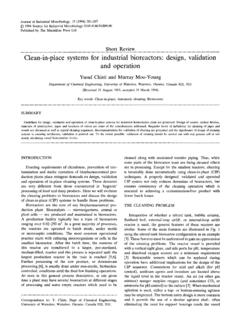
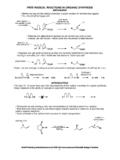
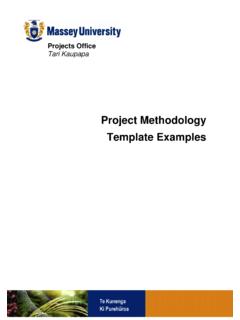
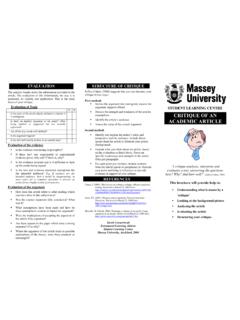
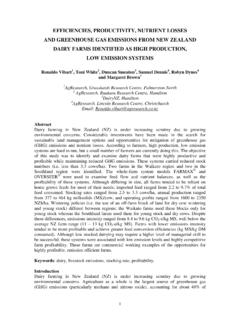
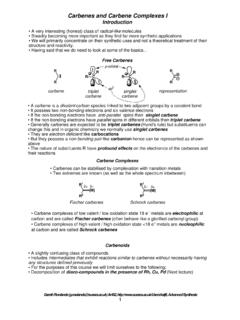
![[3,3]-Sigmatropic rearrangements - Massey University](/cache/preview/0/2/0/3/3/7/7/a/thumb-0203377a43e519e583835c335072f8b8.jpg)
